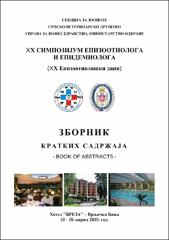Prevencija salmoneloze na farmama koka nosilja primenom živih i inaktivisanih vakcina

View/
Date
2018Author
Pajić, Marko
Knežević, Slobodan
Božić (Đurđević), Biljana
Samojlović, Milena
Todorović, Dalibor
Stojanov, Igor
Velhner, Maja
Metadata
Show full item recordAbstract
Reducing Salmonella incidence on farms will reduce its occurrence in the food chain. The World Health Organization (WHO) and the European Union have issued guidelines for reducing certain serotypes of Salmonella spp. on layer farms, which include obligatory vaccination since 2008 in countries with prevalence higher than 10%. Serovars Salmonella Enteritidis and Salmonella Typhimurium are the main causative agents of diseases in human population, while Salmonella Enteritidis is most commonly isolated in poultry in many countries. Adequate biosecurity on farms and vaccination are considered as the main strategy in combating infections caused by Salmonella spp. The aim of the vaccination is to reduce or prevent the colonization of digestive tract by salmonella, which leads to reduced possibility for contamination of feces and eggs, reduced risk of systemic infection and reduced localization of salmonella in reproductive tract. Both live and inactivated vaccines are used in our country. Live vaccines are still considered as more effective and simpler way of prevention. They are easily applied (per os), they can be applied to the day-old-chickens before they potentially come in contact with salmonella, and these vaccines can induce mucosal, cellular, and humoral immune responses. Immunity acquired after the application of live vaccines lasts longer, up to 60 weeks after the last vaccination. Inactivated vaccines are produced from attenuated strains of salmonella. They are most commonly used in chickens from 6 weeks of age and are administered intramuscularly. By using inactivated vaccines solely, chickens are not protected from salmonella in first 6 weeks and therefore often live and inactivated vaccines are combined. The immunity acquired after inactivated vaccines lasts shorter, usually up to 50-60 weeks of life. Vaccination should never be the only preventive measure. It is necessary to maintain good zoohygienic conditions on farms and quality management.
